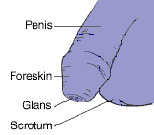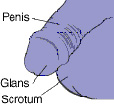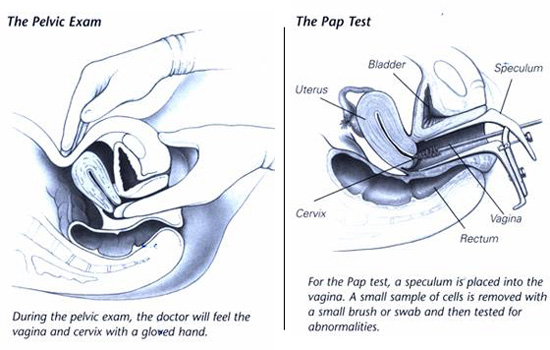Puberty is a time in a young man’s life when his body changes into that of an adult’s. It is also a time when he begins to produce sperm and therefore he is able to get a girl pregnant by having sexual intercourse. (penis in vagina with ejaculation or “orgasm”)
The following information is specific to the changes occurring to the male body:
- Testicle growth or appearance of some pubic hair is typically the first sign of puberty. This usually happens between 9- and 13-years-old.
- The penis will grow larger.
- They will experience the fastest growth spurt, on average, around 14 years of age.
- Some males’ breasts will become larger and more feminine for a while.
- As male hormones change, males will get erections more often. It’s common for erections to happen at any time, even when they are not thinking about sex. This is called a spontaneous erection.
- Males may worry about having erections in public. These erections will only last a few minutes. A well-placed jacket or book bag can prevent others from noticing.
- Males generally begin producing semen between 12- and 16-years-old.
- First ejaculations while masturbating or during a “wet dream” (ejaculation during sleep) occur.
Body Image
Males are just as concerned about body image as females are. They are bombarded by media images of men who are muscular, strong and fast. Young men may develop eating disorders, start exercising – particularly lifting weights – excessively and turn to performance and body enhancing drugs like steroids. Everyone develops differently during puberty and that it is normal to feel insecure at times.
Testosterone
Boys and girls both produce a hormone called testosterone, although boys typically produce it in higher levels.
Testosterone is involved in the development of male sex organs, as well as voice deepening and growth of facial and body hair. It can also impact behavior. Young men can experience surges of the testosterone hormone, which can cause emotional or physical outbursts.
Penis Growth
An adolescent male experiences many unfair societal and media pressures regarding the size of his penis. The size of his body is exactly what is right for him, and that is all that matters.
Hair & Shaving
As the adolescent male grows, his hair will also. While many young males are excited to start the process of shaving, it is important to get instructions on how to do it. A responsible and caring adult male can assist in this process—but moms can help, too!
Doctor Visits
All young men should see their doctor at least once a year for a check-up. You may be asked to remove your clothes and put on a gown for the exam. The doctor will feel your scrotum (testes, balls) for any lumps or bumps or other abnormalities. You should check your own testicles at home on a regular basis and notify your pediatrician if you feel anything concerning. The doctor will also check the glans (head, tip) of the penis for any discharge (drip, liquid). They may then check for a hernia by pushing part of your scrotum (sac) into something called your inguinal canal and asking you to cough (“turn your head and cough”). The entire exam takes only a few seconds to a minute from start to finish. If you have any more questions about the exam, feel free to ask you doctor before they examine you.
Male Anatomy
External:
| Uncircumcised |
Circumcised |
 |
 |
www.engenderhealth.org
Internal:
Puberty is when your body changes into an adult body. For most women, this includes the ability to have a baby.
Body Image
Growing up and puberty affect more than a young person’s outward appearance – how she feels about herself and her body image are affected, too. Having a healthy body image means that most of your feelings, ideas and opinions about your body and appearance are positive. Young people focus on their physical appearance for many reasons, including adapting to their changing bodies, making a fashion statement and finding a way to belong. Parents can help by being accepting and supportive, providing positive messages and encouraging other qualities that keep looks in perspective.
Breasts & Bras
Some young females look forward to getting breasts (boobs) and others dread them. Either way, most females are not quite certain why they have them and what to do about them.
Breasts get a lot of attention in our society and because of this some young females may worry about breast size and shape as well as nipple size and color. Breasts come in all shapes and sizes and they are all beautiful. Breast development happens in the following stages:
- Breast budding. The first stage happens during the early part of puberty, when female ovaries enlarge and estrogen, an important female hormone, begins to circulate in the body. A breast bud is like a small raised bump behind the nipple. After breast budding happens, the nipple and the circle of skin around the nipple (called the areola) get bigger and a little darker. Then the area around the nipple and areola starts to grow into a breast.
- Breast Growth. As breasts keep growing they may be pointy for a while before becoming rounder and fuller. For some females, one breast might be a little bigger than the other one. A young person’s breasts may continue to grow during the teen years and even into their early twenties.
- Adult Breasts. Even though female breasts have likely stopped growing in late adolescence, they will likely continue to change over time because of factors like weight loss/gain, pregnancy and menopause.
Once a female young person begins to have breasts, it is a good idea for her to start wearing a bra, especially when she is exercising and playing sports. A bra can also help someone feel less exposed when wearing a light t-shirt. A first bra used to be called a training bra and was designed for females who didn’t yet fit into standard cup sizes but needed basic support and comfort. These days, many first bras are sports bras – but bras come in all sizes and styles and it is important that they help pick it out so that it’s a size and material they are comfortable with.
Menstrual Cycle
The menstrual cycle is the time from the first day of one period to the first day of the next. A normal menstrual cycle can be as short as 21 days or longer than 35 days. It’s not unusual for the number of days in each cycle to vary from month to month.
- Menstrual flow (period) lasts 3 to 7 days, but it may be slightly shorter or longer. During an average period, a woman will lose four teaspoons of menstrual fluid.
- Once a woman’s period ends, hormones cause some of the eggs in a woman’s ovaries to start to ripen or mature. The hormones also cause the lining of the uterus to thicken.
- About half way through their menstrual cycle, one mature egg leaves the ovary.
- After leaving the ovary, the egg then travels through a fallopian tube toward the uterus. Most women do not feel it when they ovulate. As the egg travels, a spongy and soft lining continues to build up in the uterus.
- Some will feel pain in the lower abdomen around the time they ovulate and/or have light spotting of blood for a day or two after ovulation.
- While ovulation typically happens halfway through the menstrual cycle, this can vary, especially during the teen years.
- The uterine lining is where a fertilized egg may attach for pregnancy to begin. If pregnancy does not happen, the lining breaks down and the blood and tissue flow from the uterus through the cervix and out of the body. This is menstruation and the cycle starts over.
First Period
After a young woman gets her first period, it is not uncommon for her to see spotting, vaginal discharge or skip periods altogether. These things are part of normal development and there are many reasons why a young woman will miss her period including stress, physical activity and pregnancy.
Pads are usually easiest for females to use at first. You may have questions about what type of pad to buy, how to put a pad in their underwear, how long to wear a pad before changing it and/or how to throw out used pads. Please reach out to trusted adults in your life to learn more. You can carry a pad in your purse or backpack if you’re concerned about a period starting unexpectedly. You can also ask a trusted adult to teach you how to use tampons or menstrual cups.
Pregnancy
Pregnancy most likely happens from unprotected vaginal intercourse during the six days before ovulation. It is also possible, but not as likely, on the day after ovulation. To avoid pregnancy, some women use fertility awareness-based methods to predict when they will ovulate. They abstain from vaginal intercourse or use condoms or another kind of birth control during this time in their menstrual cycle. Cell phone apps and counting days on the calendar are unreliable ways to predict ovulation.
Doctor Visits
All teenage girls should see their doctor at least once a year for a check-up. You may be asked to remove your clothes and put on a gown for the exam. During the breast exam, the doctor is feeling for lumps, irregularities or discharge from your breasts. You should be checking your own breasts once a month at home, and notify your doctor with any concerns. The doctor may then check your external vaginal area (vagina), looking for any abnormalities such as bumps, warts or discharge. Your first internal pelvic exam (pelvic, pap) should be done by age 18 or 2 years after you first have sexual intercourse (penis in vagina), and then repeated once a year after that. This helps detect abnormalities in the reproductive organs (vagina, uterus, ovaries). The woman lies on the table and places her legs in stirrups or knee rests. To examine, the doctor gently inserts a sterile metal or plastic speculum into the vagina. They then swab the cervix (opening to the uterus) for a Pap test, which shows whether any pre-cancerous or cancerous cells are present. They may also test for sexually transmitted infections with a cotton swab at this time. After removing the speculum, the doctor will insert one or two gloved, lubricated fingers into the vagina and press down on the lower abdomen with the other hand to examine the internal organs. This entire internal exam takes only a few minutes from start to finish. If you have any more questions about the exam, feel free to ask you doctor before they examine you.

Female Anatomy
External Vagina:
Internal female organs:
en.wikibooks.org